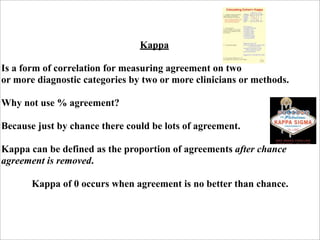
Kappa
- 1. Kappa Is a form of correlation for measuring agreement on two or more diagnostic categories by two or more clinicians or methods. Why not use % agreement? Because just by chance there could be lots of agreement. Kappa can be defined as the proportion of agreements after chance agreement is removed. Kappa of 0 occurs when agreement is no better than chance.
- 2. Kappa of 1 indicates perfect agreement. Negative Kappa means that there is less agreement than you’d expect by chance (very rare) Categories may be ordinal or nominal
- 3. How is it calculated? Patient ID Psychiatrist Psychologist 1 1 2 2 2 2 3 2 2 4 3 3 5 3 3 6 3 3 7 3 3 8 3 4 9 3 4 10 4 4 11 4 4 12 4 3
- 4. Category 1 2 3 4 1 2 1 11 3 1111 1 4 11 11
- 5. Steps 1. Add agreements = 2 + 4 + 2 = 8 2. Multiply number of times each judge used a category: (1x0) + (2x3) + (6x5) + (3x4) 3. Add them up = 48 4. Apply formula
- 6. Kappa = (N x agreements) – N as in 3 N2 – N as in 3 Which = (12 x 8) – 48 = 96 – 48 = 48 = 0.50 144 – 48 96 96
- 7. How large should Kappa be? Landis & Koch (1977) suggested 0.0 – 0.20 = no or slight agreement 0.21 – 0.40 = fair 0.41 – 0.60 = moderate 0.61 – 0.80 = good > 0.80 = very good
- 8. Weighted Kappa In ordinary Kappa, all disagreements are treated equally. Weighted Kappa takes magnitude of discrepancy into account (often most useful); is often higher than unweighted Kappa.
- 9. N.B. Be careful with Kappa if the prevalence of one of the categories in very low (< 10%); this will underestimate level of agreement. Example: If 2 judges are very accurate (95%) a Kappa of 0.61 with a prevalence of 10% will drop to • 0.45 if prevalence is 5% • 0.14 if prevalence is 1%.